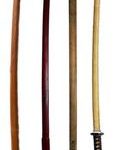 Japan has played an instrumental role in the world’s bladesmithing practice. Since the region’s feudal period, bladesmiths here have pioneered a variety of high-quality swords, knives and bladed weapons. But while most people are familiar with the katana, Japan has paved the way for countless other swords, including the bokken. To learn more about the bokken and how it was used, keep reading.
Japan has played an instrumental role in the world’s bladesmithing practice. Since the region’s feudal period, bladesmiths here have pioneered a variety of high-quality swords, knives and bladed weapons. But while most people are familiar with the katana, Japan has paved the way for countless other swords, including the bokken. To learn more about the bokken and how it was used, keep reading.
Overview of the Bokken
The bokken isn’t your ordinary traditional Japanese sword. Although it was invented during feudal Japan — around the same time as the katana — it didn’t feature an actual “live” blade. Rather, the bokken was a practice sword that featured a wooden construction. It was used by samurai warriors during training sessions to minimize the risk of self-injury, thereby allowing them to practice in a safe environment.
Of course, the katana remained the preferred choice of weapon among samurai warriors during feudal Japan. With its moderate length, curved blade and high-carbon steel, it offered an unparalleled level of versatility on the battlefield. Therefore, samurai warriors would train with a bokken featuring a similar size and design. As shown in the image above, the bokken was strikingly similar to a traditional katana, with the only real difference being its construction. While the katana was made of high-carbon steel — known as tamahagane steel — the bokken was made of wood. This allowed samurai warriors to train and perfect their technique while minimizing the risk of self-injury in the process.
History of the Bokken
According to Wikipedia, the bokken first appeared during Japan’s feudal period. Reports indicate that kenjutsu master Miyamoto Musashi was able to fight — and win — duels with fully equipped competitors while carrying only one or two bokken. In one legend, Musashi was traveling on a boat to prepare for a duel when he carved a bokken out of a wooden oar. Once he arrived on the island for the duel, he used this newly crafted bokken to defeat his opponent.